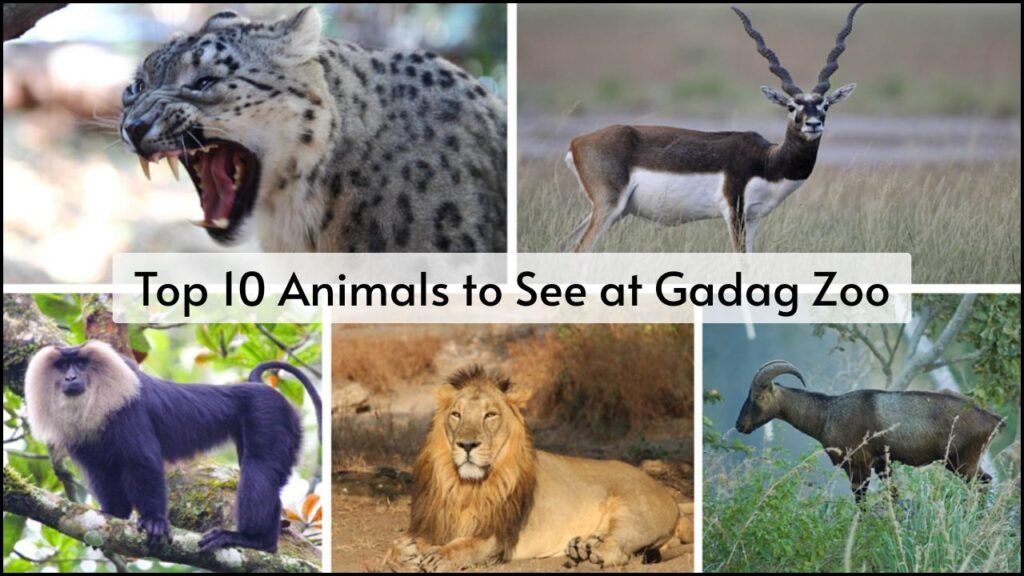
Gadag Zoo, located in Karnataka, is known for its unique mix of native and exotic animals. This zoo may not be as large as others in India, but it offers a special experience for visitors who love wildlife. Gadag Zoo focuses on conservation, education, and creating a safe home for various species. The zoo helps people connect with nature and learn about animal behavior, habitats, and threats. Below are the top 10 animals that make a visit to Gadag Zoo memorable and exciting.
Table of Contents
1. Bengal Tiger
- Scientific Name:Panthera tigris tigris
- Habitat: Dense forests and grasslands
- Diet: Carnivore – feeds on deer, wild boar, and other large animals
- Features:
- Bright orange coat with black stripes
- Powerful build and sharp teeth
- Excellent swimmer
- Special Note:
- The Bengal tiger is India’s national animal and a symbol of strength
- Gadag Zoo participates in efforts to protect this endangered species
2. Indian Leopard
- Scientific Name:Panthera pardus fusca
- Habitat: Forests, rocky areas, and grasslands
- Diet: Carnivore – eats small to medium-sized animals
- Features:
- Golden-yellow fur with black rosettes
- Agile climber and fast runner
- Mostly active during the night
- Special Note:
- Indian leopard helps maintain balance in the food chain
- Zoo enclosure allows visitors to observe its stealthy movements
3. Sloth Bear
- Scientific Name:Melursus ursinus
- Habitat: Grasslands, forests, and scrublands
- Diet: Omnivore – enjoys termites, ants, honey, and fruits
- Features:
- Shaggy black fur with a V-shaped white patch on the chest
- Long curved claws for digging
- Nocturnal and shy
- Special Note:
- Often uses its lips like a vacuum to suck up insects
- Sloth bears are native to India and need protection due to habitat loss
4. Indian Star Tortoise
- Scientific Name:Geochelone elegans
- Habitat: Dry areas, grasslands, and scrub forests
- Diet: Herbivore – feeds on grasses, fruits, and flowers
- Features:
- Shell marked with yellow and black star-like patterns
- Moves slowly and stays low to the ground
- Can live for many years
- Special Note:
- Star tortoise is often smuggled illegally, so zoo care is crucial
- Conservation status is vulnerable
5. Spotted Deer (Chital)
- Scientific Name:Axis axis
- Habitat: Grasslands and forest edges
- Diet: Herbivore – eats grass, leaves, and fruits
- Features:
- Brown coat with white spots
- Males have branched antlers
- Lives in herds for safety
- Special Note:
- Plays a vital role as prey for big predators
- Easily visible and a favorite among children
6. Peafowl (Indian Peacock)
- Scientific Name:Pavo cristatus
- Habitat: Forests, villages, and open farmlands
- Diet: Omnivore – eats seeds, insects, and small creatures
- Features:
- Bright blue body and long, colorful tail feathers in males
- The female (peahen) is brown and smaller
- Known for graceful dance during rain
- Special Note:
- National bird of India
- Peacocks often display their feathers to attract mates
7. Indian Cobra
- Scientific Name:Naja naja
- Habitat: Forests, fields, and near human settlements
- Diet: Carnivore – feeds on rodents, frogs, and birds
- Features:
- Hood with eye-like markings
- Smooth, shiny scales
- Can raise the front part of the body and hiss
- Special Note:
- Featured in Indian mythology and culture
- Gadag Zoo keeps it in a secure glass enclosure for safety
8. Blackbuck
- Scientific Name:Antilope cervicapra
- Habitat: Open plains and grasslands
- Diet: Herbivore – prefers grasses and herbs
- Features:
- Males have long, spiral horns and a dark coat
- Females are lighter in color and hornless
- Fast runners and graceful movers
- Special Note:
- Listed as near-threatened due to habitat loss
- Known for their beauty and speed
9. Indian Monitor Lizard
- Scientific Name:Varanus bengalensis
- Habitat: Forests, rocky hills, and villages
- Diet: Carnivore – eats insects, small birds, and rodents
- Features:
- Long body with rough scales and a forked tongue
- Strong limbs and sharp claws
- Can climb trees and swim
- Special Note:
- Not venomous, but very alert
- Often misunderstood and harmed, the zoo plays a role in educating visitors
10. Bonnet Macaque
- Scientific Name:Macaca radiata
- Habitat: Forests and urban areas
- Diet: Omnivore – eats fruits, seeds, and small animals
- Features:
- Brownish-grey coat with a distinct hair crown
- Lives in groups and shows strong social behavior
- Active and noisy during the day
- Special Note:
- Native to South India
- Gadag Zoo provides an open and enriched space to support their active lifestyle
Animal Overview
| Animal | Scientific Name | Habitat | Diet | Special Feature |
|---|---|---|---|---|
| Bengal Tiger | Panthera tigris tigris | Forests and grasslands | Carnivore | National animal with a powerful build |
| Indian Leopard | Panthera pardus fusca | Forests and rocky areas | Carnivore | Fast, agile, with spotted coat |
| Sloth Bear | Melursus ursinus | Forests and scrublands | Omnivore | Shaggy fur and long claws |
| Indian Star Tortoise | Geochelone elegans | Grasslands and dry areas | Herbivore | Star-like shell pattern |
| Spotted Deer | Axis axis | Forest edges | Herbivore | White-spotted coat and antlers |
| Indian Peafowl | Pavo cristatus | Farmlands and forests | Omnivore | Bright feathers and elegant dance |
| Indian Cobra | Naja naja | Fields and forests | Carnivore | Hood with markings, feared snake |
| Blackbuck | Antilope cervicapra | Grasslands | Herbivore | Spiraled horns and fast running |
| Monitor Lizard | Varanus bengalensis | Forests and rocky areas | Carnivore | Rough-scaled, agile climber |
| Bonnet Macaque | Macaca radiata | Forests and towns | Omnivore | Fast, agile, with a spotted coat |
In Summary
Gadag Zoo offers a rare chance to see native and exotic animals in one place. Each animal at the zoo plays an important role in its ecosystem and helps teach visitors about wildlife protection. From the powerful Bengal tiger to the shy star tortoise, every creature adds something special to the zoo experience. A visit to Gadag Zoo is not only entertaining but also educational, especially for children and nature lovers.





